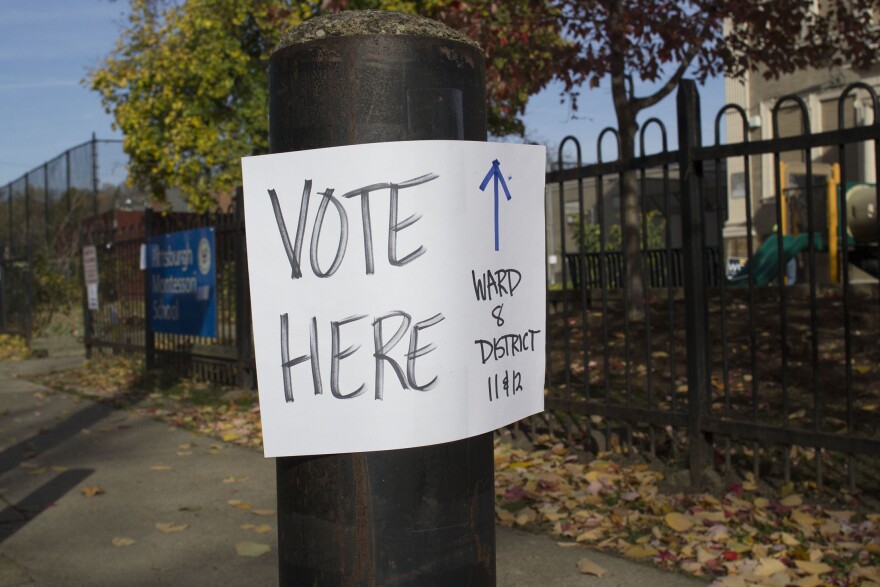Allegheny County election officials have been on a shopping spree, having bought 40,000 blue pens, 15,000 folders, 5,000 clip boards, eight high-speed scanners, two high-speed letter openers and 1,400 rolls of "I Voted" stickers ahead of the 2020 primary.
The list reflects the county’s efforts to carry out this year's primary and general election without a hitch. New state election rules allow any registered voter to cast a mail-in ballot, and ease voter-registration deadlines so people can register to vote up until two weeks before the election. The 2020 primary will also be the first time every county in the state will use new voting machines that provide a paper trail of votes cast.
On Tuesday, Allegheny County election officials answered a wide range of questions from the public and the Board of Elections about what to expect in the April 28 Pennsylvania primary, but warned that voters may have to be patient when waiting on results. Poll workers aren't allowed to start counting ballots until 8 p.m. on election night.
"They're not allowed to start opening them until after the polls close," said Allegheny County Executive Rich Fitzgerald. "We might be [waiting] many many hours" for results.
What will happen when I go to vote?
Election officials say that after signing in at their polling place, each voter will be handed a ballot and a folder. Poll workers will then lead voters to a private area where they will fill out their ballot. Voters will place the marked ballots into their folders (officials occasionally referred to them as "secrecy sleeves") and be taken to the ballot scanner. There voters will insert their own ballots into the scanner, which is equipped to accept a ballot any way it is inserted. The machine will drop each ballot into a sealed, locked box below, and notify the voter that the ballot has been received. Poll workers will be nearby in case of problems.
At the end of the night, election workers will use a key to unlock the ballot box and put the ballots into a secure container, which will be sealed and taken to a regional counting location.
How and when will mail-in ballots be counted?
Under the state's new election law, anyone can request to vote by mail, and officials expect many more people will do so. Voters must apply for a mail-in ballot no later than April 21 at 5 p.m.: Election officials must receive the marked ballots by 8 p.m. on Election Day.
(Absentee ballots are also still available, although they have the same deadlines, and voters must provide a reason for needing them.)
Mailed-in ballots will be tallied at the Division of Elections warehouse. In preparation for the influx of ballots officials expect, the county purchased two high-speed letter openers that can open 700 envelopes per minute. Those ballots will then be fed into one of eight high-speed scanners to tabulate the results. Each scanner can process up to 300 ballots per minute.
According to the new law, election workers must wait until polls close at 8 p.m before they can begin opening mailed-in ballots. County officials noted that as a result, election results may take longer to be announced.
How do I apply for an absentee or mail-in ballot in Pennsylvania?
Go online to pavoterservices.pa.gov. If you want to request an absentee ballot, you need to show that you’ll be out of town or unable to get to your polling place. If you don’t qualify for an absentee ballot, any registered voter qualifies for a mail-in or “no excuse” ballot.
How will I know if my mail-in ballot has been received?
Once your application has been approved, you’ll be able to go online at pavoterservices.pa.gov and see that your request has been received. The envelope for each mail-ballot has its own barcode, which will be scanned out when it is mailed to you and scanned in when your completed ballot has been received by the election bureau. You can see the status of your ballot online.
How are officials dealing with security concerns?
Allegheny County election officials are developing a “very robust” documentation process to address security concerns.
Election workers will have a total of how many ballots were sent to each polling place, how many were scanned, and how many were returned. Mail-in ballots will be kept in the election division’s office in a locked room until it’s time to count them.
This post was updated on February 12 at 4:15 p.m. with more details.




